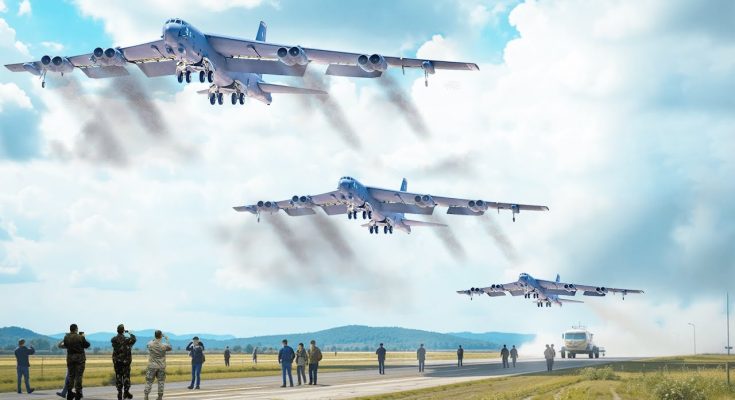US-Houthi Tension Rise: Four US B-52 Bomber Emergency Takeoff at Full Speed
In response to escalating tensions in the Middle East, particularly involving the Houthi rebels in Yemen, the United States has raised its military readiness with an extraordinary display of power — four B-52 Stratofortress bombers conducting an emergency takeoff at full speed. The strategic move is part of the U.S. military’s heightened alert to address potential threats in the region and demonstrate its ability to quickly mobilize for combat situations.
Background: The Houthi Threat
The Houthi rebels, backed by Iran, have been engaged in a prolonged conflict with the Yemeni government, which is supported by a coalition of Saudi Arabia and other Gulf states. The Houthis have increasingly targeted international shipping lanes and military assets, creating instability in the region. Their missile attacks on Saudi Arabia and other U.S. interests in the region have further escalated tensions. The U.S. military’s response to these growing threats underscores its commitment to protecting vital interests and allies in the region.
The U.S. military has closely monitored the situation, especially after a series of missile launches by the Houthis that have targeted civilian and military assets, as well as the increased Iranian influence in the region. In this volatile environment, the B-52 bombers, long considered a symbol of American deterrence, were called into action.
B-52 Stratofortress: The Backbone of U.S. Airpower
The B-52 Stratofortress, a long-range strategic bomber, has been a key part of the U.S. Air Force arsenal since the 1950s. Known for its massive payload capacity and ability to deliver both conventional and nuclear weapons, the B-52 can strike targets over long distances with unmatched precision. With a range of over 8,000 miles and the capability to carry up to 70,000 pounds of munitions, the B-52 is a key asset in the U.S. military’s global deterrence strategy.
These bombers are capable of flying in a variety of conditions, including dangerous conflict zones, and can be equipped with a wide range of weapons for precision strikes. In the current context, they provide a clear demonstration of U.S. military reach and strength, signaling to both adversaries and allies that the U.S. is ready to act decisively.
The Emergency Takeoff: A Show of Force
The emergency takeoff of the four B-52 bombers is a deliberate display of military preparedness. The bombers took off from their base at Barksdale Air Force Base, Louisiana, and conducted high-speed takeoff procedures, simulating a real-world combat scenario. This kind of rapid deployment is designed to ensure that the U.S. can quickly respond to any potential threats in the region, including missile attacks, airspace violations, or aggressive actions by the Houthi rebels.
Full-speed takeoff exercises are essential for ensuring that bombers can reach critical regions, including the Middle East, with minimal delay. The B-52s were fueled and armed for high-intensity missions, capable of carrying out precision bombing runs or standing ready for deterrence missions to ensure that the U.S. can maintain air superiority in volatile regions.
The military’s use of multiple bombers for this exercise signifies the seriousness of the U.S. commitment to regional stability. These B-52 bombers are not only capable of striking targets but also serve as an intimidating presence that can deter further escalations in the region.
Strategic Implications: A Show of Deterrence
This dramatic response comes amid growing fears of an expanded proxy war in the region, particularly with increasing Iranian influence and the Houthi group’s growing missile capabilities. The U.S. aims to demonstrate that it has the ability to swiftly respond to any escalation, making it clear that any aggressive actions from groups like the Houthis will not go unchecked.
-
The emergency takeoff showcases the U.S. Air Force’s ability to project power rapidly, even in contested or unstable environments.
-
The B-52 bombers provide a credible deterrence against any further hostile actions from the Houthis, while also reassuring allies in the region, such as Saudi Arabia and the United Arab Emirates, that the U.S. is committed to safeguarding their security.
-
These bombers are capable of delivering precision strikes on a wide variety of targets, including Houthi missile launch sites, weapons depots, and critical infrastructure, if necessary.
Looking Ahead: U.S. Military Presence in the Region
The recent exercise involving the B-52 bombers is part of a broader strategy to ensure that the U.S. military maintains a visible and effective presence in the Middle East. As tensions rise, particularly with the threat of Iranian-backed Houthi activities, the U.S. Air Force is positioning itself to respond at a moment’s notice.
The 2025 modernization plans for the B-52, which include upgrades to weapons systems, avionics, and engine technology, will further enhance the bomber’s capabilities. The strategic flexibility of the B-52, with its capacity to carry an array of advanced weapons and operate at extended ranges, makes it a critical asset in ensuring regional stability and projecting power in times of crisis.
Conclusion: Unstoppable Power in the Skies
The four B-52 bombers taking off at full speed in an emergency response to rising U.S.-Houthi tensions is a stark reminder of the U.S. military’s unmatched capability to deploy force when necessary. With enhanced technology and strategic readiness, the 2025 B-52s are not just a tool of warfare, but a clear message of deterrence.
In an age of evolving threats and complex geopolitical dynamics, the B-52 Stratofortress continues to stand as a pillar of American military power — ready to respond at a moment’s notice, ensuring that adversaries know that the U.S. can strike anywhere, anytime, with precision and overwhelming force.



